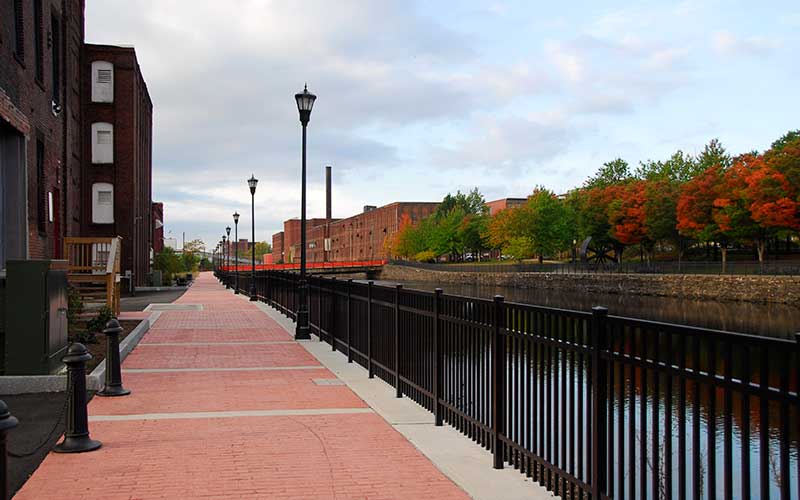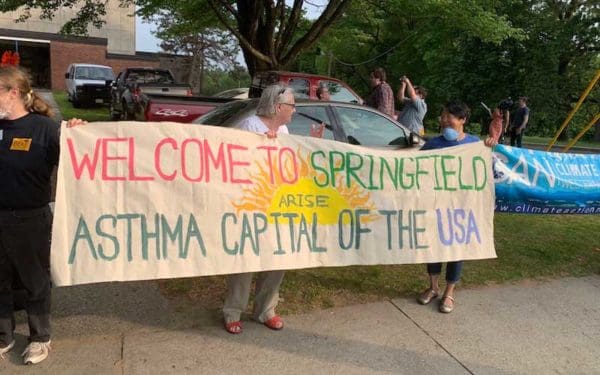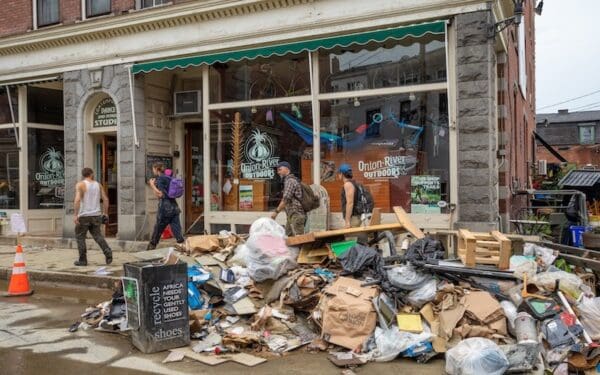
Holyoke is considering what it would take to become a more resilient, climate-ready community. Photo: CC_mtneer_man_Flickr
Over the past week, we’ve discussed what environmental justice legislation is, why it’s needed, and why now is the time to sign it into law in Massachusetts. But beyond the need to redress decades of environmental racism and give every community a chance for agency, what does a neighborhood actually look like with successful environmental justice legislation in place?
We all have a vision of what we want for our community. So, for those fighting on the front lines, what do they want to see?
For the final installment of our series, I posed this question to María Belén Power from GreenRoots, Andrea Nyamekye of Neighbor to Neighbor, and my CLF colleague Staci Rubin. I asked them their vision for a community that’s protected, and what it would mean for environmental and climate protections to be just
Below is an excerpt from our conversation, edited for clarity.
Members of low-income, immigrant, and communities of color live long, healthy lives.
María Belén Power, GreenRoots: Where we need to be is where low-income communities, Black and Brown communities, and immigrant communities who don’t speak English are living long and healthy lives – the same way communities that are white and wealthy are.
This requires a lot of proactive work. If we sit back and don’t do anything, the injustices and the inequities will continue and will keep on growing. It requires proactive action to make sure that the communities that have been the most overburdened are actually protected and therefore living long and healthy lives without public health concerns – and without the worry of having to live in a neighborhood with a hazardous or polluting facility.
All communities have clean energy and clean air.
María Belén Power, GreenRoots: I want to highlight that this is not just about the siting of polluting [power plants]. It’s also about shifting our economy and the way we generate energy, and [changing] the way we produce things that we need like food. And so, this isn’t just about “let’s not have a substation in East Boston, let’s put it in Cambridge [instead].”
It’s about transforming how we how we build the world that we want to see.
One of the ways [we can do this] is [with] a micro grid. For example, we’re saying no to [Eversource building a] substation in East Boston, but we’re also saying there are solutions – and Eversource knows them. They’ve done this before – we saw the battery storage system that they installed in Martha’s Vineyard, so it’s not like they don’t know what’s at the cutting edge of these technologies and how we can make sure that we’re creating cleaner energy and doing it in a less dangerous way.
So, it’s about not only the sighting [of industrial facilities], but about transforming our economy to a more decentralized and regenerative one.
Community residents are the decisionmakers for their own neighborhoods.
Staci Rubin, CLF: What my vision looks like is that there’s a disproportionately high amount of resources in [environmental justice] communities. People from these communities are our elected and appointed officials, and our future governing systems are run by people who know best how to do right by their own communities.
It’s also about quality jobs. Instead of having Black and Brown people risking their lives on a day-to-day basis driving our buses right now [because they can’t afford not to], we make those the jobs that are really well paid. Those are living wages. And, ideally, people would not have to put their lives at risk to earn a paycheck.
It’s also low-income transit fares, community solar, and the other resources that María Belén is talking about. And it’s everybody [being able to] pay their bills, [so that] nobody has to choose between paying their utility bill and buying food or getting medicines for their kids.
Communities are creating and owning local resources.
Andrea Nyamekye, Neighbor to Neighbor: Our current systems have been causing ecological collapse, and it’s because we think about maximizing profits and growth and extracting our resources. But our resources are finite. And with Neighbor to Neighbor, our vision has been around a just transition and a solidarity economy. [We’ve been] playing with those two frameworks and thinking about how a solidarity economy or a just transition can actually shift us away from the extraction of our earth and our resources and also the exploitation of labor.
And so localizing and municipalizing our resources, our work, our labor, and our governance. [Bringing these] to the local level so communities can actually express self-determination and think about “how do we collectively grow our food,” or “how do we collectively have an energy system that is renewable that the community can run,” or “how do we have collective housing that is not exploitative and causing evictions and high rent costs?”
It’s bringing a lot of things down to the local level and ensuring that communities have access and the ability to actualize the changes that they wish to seek.
[For example,] in Western Massachusetts in our Holyoke chapter, there are two projects. The first is thinking of a climate action plan with the City of Holyoke that centers residents – to think and dream about what Holyoke would look like if it were resilient, if we cared about its workers, [and] if we nurtured the land. What policies need to be implemented so [this can happen]? Then transitioning the city off of fossil fuels into a renewable energy economy.
Communities can respond to and recover from disasters like climate change and COVID-19.
Andrea Nyamekye, Neighbor to Neighbor: The second thing that we are experimenting with in Holyoke is creating a climate resiliency hub. But really, it’s just a resiliency hub, period.
There’s a lot of historical context in Holyoke. I believe [roughly] 52% of the folks in Holyoke are people of color, many of them coming or descended from Puerto Rico. Hurricane María was a huge, drastic event that happened in Puerto Rico. The ripple effect was having 2,000 or so climate refugees then come to Holyoke.
So, thinking about the climate resiliency project was new and important for us because it’s also understanding that the entire planet is interconnected. One thing may happen in Puerto Rico, [and] there are ripple effects that happen in our other communities.
With the resiliency project, we are experimenting around having workshops so people can start creating their own worker cooperatives. [We’re also looking at] putting people into clean energy or renewable jobs through apprenticeship workshops.
And, lastly, food security has been a major thing that has come up for Holyoke residents. We are experimenting with what it could look like for us to have a community farm – where the community helps to grow the food and gets the food out. [It would be] a regenerative cycle that we can have in our city that starts to localize our production, our labor, and our collective work back into the hands of the people living there.
That’s our vision. If we could do that everywhere, I’d be happy.
The government protects and benefits all people equitably.
María Belén Power, GreenRoots: The other piece is shifting the business models of these [energy] industries and how they operate for the greater good – or how they don’t operate for the greater good. We know that, in the example of the East Boston substation, all of that money that Eversource is going to use to build it – they’re going to get a return on [that] investment. So it doesn’t matter whether [the substation] is actually needed or not. It just matters that [Eversource] is going to get the money back and that [the costs] are going to be passed on to ratepayers. And so part of [environmental justice protections] also has to do with shifting those business models so that they operate for the greater good.
I think that’s the role of government. That’s how we see it play out in the rest of the world and in Europe. The role of government is to protect its people, it’s to regulate how money is made in these industries and how we are transforming the generation of energy so that we’re slowing down climate change as much as possible.
And that would, of course, protect every community. But it would protect even further the communities that are most vulnerable to climate change.
We need environmental justice legislation to help bring about change.
These inequities are the result of decades of racist policies and won’t be addressed without strong legislation to drive change. Local organizations are doing great work to reduce burdens on environmental justice communities, but it’s up to the Massachusetts legislature to redress decades of wrongs and put our state on a path to a more equitable future.
Support these bills by contacting your elected officials in support of H.4264, S.464, and S.453. Call or email House and Senate leadership, as well as the House and Senate Ways and Means Chairs, and tell them you support these bills.
This blog is one in a series about environmental justice in Massachusetts, and the critical work being done in the legislature to address it. Read the entire series here.
María Belén Power is the Associate Executive Director of GreenRoots, a community-based and resident-led environmental justice organization working in Chelsea and East Boston, Massachusetts.
Andrea Nyamekye is the Campaign and Policy Director at Neighbor to Neighbor, a Massachusetts-based grassroots power-building organization working to improve quality of life for local communities.
Staci Rubin is a Senior Attorney at CLF focusing on transportation advocacy and its intersection with public health and the climate crisis.



